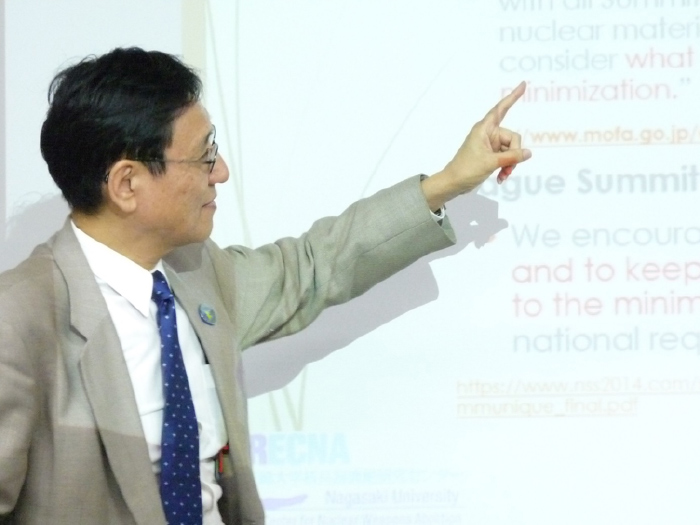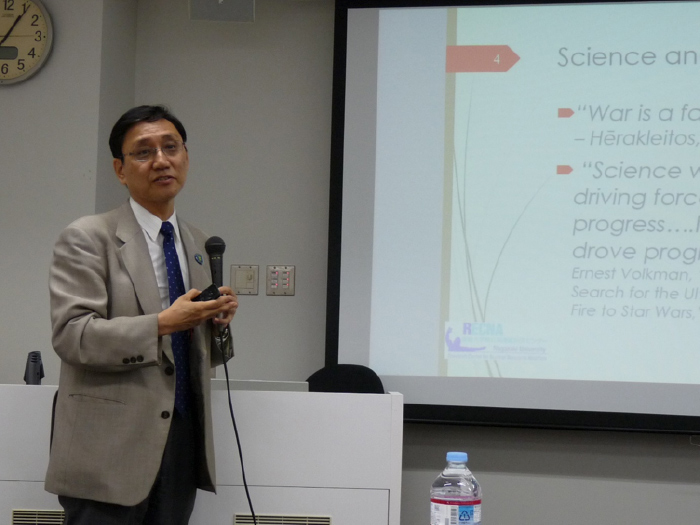SSU Forum with Professor Tatsujiro Suzuki
| Date: | Friday, October 10, 2014, 13:00-14:30 |
|---|---|
| Venue: | Kojima Conference Room, 2nd floor, Kojima Hall |
| Subject: | Science, Technology, and Security: Issues on Plutonium |
| Lecture: | Dr. Tatsujiro Suzuki (Vice Director, RECNA/Professor, PARI) |
| Language: | English |
| Hosted by: | Security Studies Unit, Policy Alternatives Research Institute, the University of Tokyo |
The SSU was delighted to host a lecture delivered by Professor Tatsujiro Suzuki in the framework of the SSU Forum. The lecture offered a healthy reflection on the complex web of relations between the domains of science, technology, and security, with a particular practical focus on the issue concerning the management of the plutonium production cycle.
SSU Director Professor Kiichi Fujiwara opened the session introducing Tatsujiro Suzuki, Vice Director of the RECNA (Research Center for Nuclear Weapons Abolition) at the University of Nagasaki, and Professor at the University of Tokyo, as an outstanding scientist, who not only has been trained as a nuclear engineer, thus possessing a vast knowledge on scientific and technological questions, but he developed over the years an articulated competence in the social scientific aspects of technology and its security implications.
After thanking Professor Fujiwara for the introduction, Professor Suzuki has opened his lecture by providing a general conceptual framework in which the plutonium issue has to be understood. He therefore highlighted the historically proven relation between warfare and technological and scientific discoveries, as in the famous work by Ernest Volkman Science Goes to War (2002). Because a complex system of feedbacks can be identified between science, technology, and security issues, any scientist and/or engineer has to be aware of the security implications of his research, inventions, and discoveries. This is particularly important considering how, at closer scrutiny, any dichotomy between “civilian” and “military” technology shows grey areas indicating the largely artificial nature of such distinctions, whereas instead a “dual use” of a given technology is always possible.

Professor Suzuki, having explained the rationale underscoring the necessity for scientists to care more about the security implications of their work, successively moved on to introduce the case of the plutonium production cycles and related technologies.
Already in 1946, at the dawn of the atomic era, the Achison-Lilienthal Report identified the risks of nuclear proliferation emerging from the sheer spread of nuclear technologies for civilian use. Energy coming from nuclear fission is six orders of magnitude more concentrated than energy derived from the combustion of fossil fuels. However, nuclear weapons and commercial nuclear reactors do not function in the same way. Nuclear weapons can be built with a kg order of fissile material, which has to be HEU (Highly Enriched Uranium) or plutonium, while commercial nuclear reactors require tonnes of fissile material, although only using natural or LEU (low-enriched uranium) (4-5% against 90% concentration in HEU) or plutonium. Consequently, there is a large area of overlap between military and civilian use of nuclear technologies. The main difference consists in the fact that HEU is difficult to produce, but once obtained, the construction of weapon becomes relatively easy, while plutonium is easy to produce, but a plutonium bomb is difficult to build, and requires testing. HEU global stockpiles are not entirely known in all transparency, but it is possible to convert HEU to LEU for re-use in power plants. It is also technologically possible to produce a significant amount of HEU with a small enrichment plant in a very limited amount of time (even days), although it is very difficult to change such operation mode under the international safeguards. This underscores even more the necessity to monitor any enrichment plant and its activity.
Global plutonium stockpiles are large, and this is mostly due to the production of plutonium as by-product in commercial reactors.
Focusing on the plutonium production cycle in particular, Professor Suzuki explained how re-processing of nuclear fuel, where plutonium occurs as a by-product, is technically easy but not an economically reasonable practice as opposed to a “once-through” policy, which on the other hand would pose less security concerns. Of course, because of the production of plutonium, a security question immediately arises regarding its stockpiling and use.
Although the Japanese government has previously endorsed the view that the plutonium produced in commercial reactors does not consists in isotopes suitable for nuclear weapons, Professor Suzuki expressed the view that this is not entirely correct, and the wording chosen by the government on this matter can be misleading. Instead, separated plutonium, despite its grade, can always be used for military purposes, and it has therefore to be monitored carefully. Professor Suzuki emphasized his struggle during his time serving at the Japan Atomic Energy Commission (JAEC) to put the right wordings accurately into the Chairman's Report (June 5, 2012).
In Japan, because all nuclear reactors were taken to a halt after the Great East Japan Earthquake of 2011 and no reprocessing activities were taken, the fissile plutonium stockpile is no longer growing. The JAEC endorses a “no plutonium surplus policy”, whereby Japan does not possess any plutonium which is not earmarked for a specific purpose. In order to increase the transparency on this issue, Japan has published the data concerning its plutonium stockpile every year since 1994. It also advocates a future trajectory where plutonium stockpiles will be reduced, regardless of the future recycle options which will be chosen in the future.
Recently, there has been some international concerns about some unreported 640 kg of nuclear fuel, which Japan has erroneously failed to include in its annual report to the International Atomic Energy Agency in 2012 and 2013. This error was due to the fact that the MOX fuel loaded in the No.3 reactor at the Kyushu Electric Power Co.’s Genkai plant in Saga in March 2011, remained idle for two years when it was finally removed. Professor Suzuki has expressed the view that Japan should make an effort to improve its reporting activities.
Despite this slippage, Japan has been praised by the international community for its effort in taking security questions of nuclear technologies into due account. The government of Japan remains committed to the policy of not possessing plutonium stockpiles of undetermined use, on the premise of the peaceful use of plutonium. A flexible approach is in any case required given a number of uncertainties, including technological trends, the supply-demand balance, and the international situation. There is therefore a need to ensure a degree of strategic flexibility in this kind of activities.

At the moment however, Japan’s nuclear fuel policy has not been changed due to a series of uncertainties, ranging from concerns over nuclear fuel supply, to the legal definition of spent fuel as a “resource” as opposed to “waste”, to the sheer difficulty of building large alternative infrastructures. Japan’s future policy may change in the direction of taking measures to expand spent fuel storage capacities, including the direct disposal of spent fuel; of establishing an institutional scheme to allow the independent assessment of policy/technology options; enhancing a flexible nuclear fuel cycle management, while keeping the commitment to minimize the plutonium stockpile; finally, leading international efforts on nuclear fuel supply stabilisation and on multinational approached on fuel cycle activities.
After reviewing the situation of international cooperation on this point, Professor Suzuki has suggested possible options for future cooperation initiatives specifically focusing on Northeast Asia, including the creation of a common LEU fuel bank and a multinational enrichment corporation, a mutual inspection and trust building scheme, and an international plutonium disposal scheme.
In the last part of his lecture, Professor Suzuki has returned to the point of the scientist’s responsibility on matters of technological use and its impact on social and security realities, on the example of Dr. Joseph Rotblat, who abandoned the Manhattan Project as soon as he knew that Germany was not about to build an atomic bomb. Professor Suzuki has then briefly summarised the history of the Russell-Einstein Manifesto (1955) and introduced the activities of the Pugwash Conference, which consists in the activities of leading scientists concerned with the threat that nuclear weapons pose to mankind as a whole. The Pugwash conference works on the principle of frank and open view exchange, where common ground is constantly sought despite all differences. While they do not represent any state or interest in particular, they advocate the elimination of nuclear weapons and war as their final objective. Professor Suzuki concluded his lecture by expressing his satisfaction that the 2015 Pugwash annual conference will be taking place in Nagasaki, on the 70th anniversary of the atomic bombing of the city.
